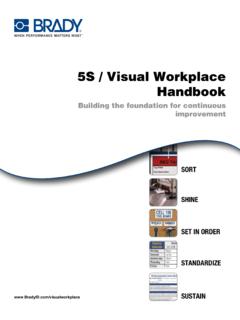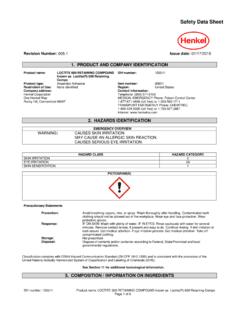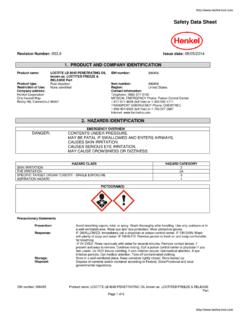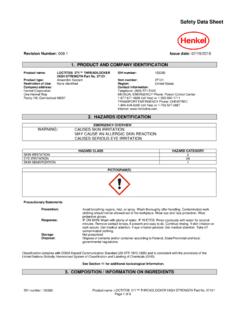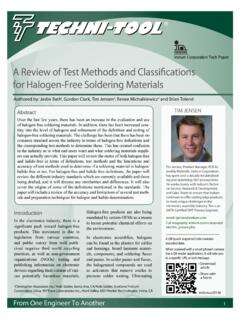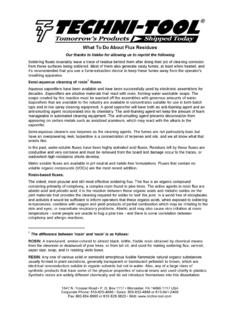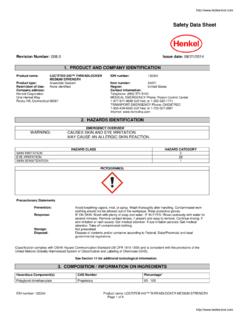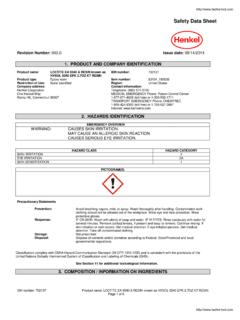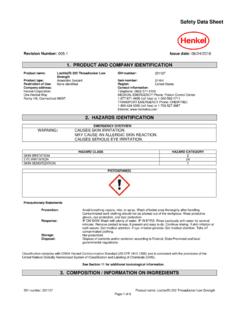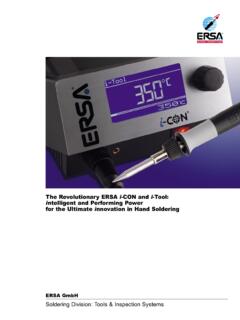Transcription of Pace - Hand-Solder Training Critical in SMT Assembly ...
1 1547 N. Trooper Road P. O. Box 1117 Worcester, PA 19490-1117 USA Corporate Phone: 610-825-4990 Sales: 800-832-4866 or 610-941-2400 Fax: 800-854-8665 or 610-828-5623 Web: Hand-Solder Training Critical in SMT Assembly , Rework and Repair Our thanks to PACE for allowing us to reprint the following. By: Christopher S. Barrett, Director of Training , PACE Incorporated The evolution of the electronics printed circuit board continues to surprise, amaze and befuddle even the most experienced industry professionals. Like the products in which they eventually reside, what is state-of-the-art today, is yesterday s news tomorrow. Component packaging, bare-board design, attachment technology and solder alloys are all advancing at lightning speed, always with an eye towards smaller, faster, and more complex, capable of doing more today that they could even mere months ago.
2 And along for the ride are the methods in which the finished assemblies are manufactured, inspected and tested, have faults diagnosed and finally reworked. Surprisingly, despite the advances in manufacturing technology across the board and industry-wide, there remains an element that has largely gone unchanged since the beginning, the human element: 1. Hand placement of components pre-oven or pre-wave, 2. Hand soldering of unique package styles, 3. Manual engineering sample builds, small production runs and of course, and 4. Manual rework. These are just some examples in which the human element is ingrained in the overall manufacturing process, and there seems to be no real end to this requirement any time soon.
3 It is realistic then, to suggest that the human element is every bit as important to the overall printed circuit board manufacturing process as the high-dollar, high-speed manufacturing machines themselves. Unfortunately, the human element, especially as it pertains to SMT Assembly rework and repair, is all too often overlooked in today s electronics industry. It is easily lost in the discussions related to production capacity, placement accuracy, inspection technology, functional testing and quality control programs. How important is SMT hand Assembly , rework and repair? Here s an example: A technical school graduate is charged with removing and replacing a defective surface mounted component from an intricate multilayered printed circuit board.
4 This scenario is played out daily in virtually every PCB manufacturing facility in the world. After several attempts and repeated applications of heat, the technician is finally successful in removing the component. However, during the process he or she has also removed or damaged several lands there were connected through vias to internal circuitry. What was initially a fast, and inexpensive repair has suddenly become a very costly and time consuming one or worse, a repair that the company will not perform, thus scrapping the entire Assembly . The knee-jerk reaction is often to ask; why can this highly trained and skilled technician diagnose the problem so quickly but cannot effectively rework the faulty component with the same ease?
5 The answer is simple, albeit unfortunate; throughout the history of electronics printed circuit boards, the rework function has largely been viewed as subordinate to original Assembly , troubleshooting, diagnostics and inspection. The notion however, that the skill and precision of the process is built into the machines and technology and not the human element has always been, and will always be, antiquated. Throughout the history of electronics, the primary emphasis on education has been on functional aspects, component and circuit theory, PCB design, and fault and defect detection. Often this results in technicians, assemblers and engineers entering a job market which requires them to perform practical tasks in which they have little or no experience or background.
6 While they may be extremely proficient in PCB design or diagnostics, they have been taught very little about performing the actual repairs. This, of course, pervades all corners of a manufacturing floor. The Bigger the Blob, the Better the Job In the infancy of electronics Assembly , printed circuit board technology was relatively simple and inexpensive. 1547 N. Trooper Road P. O. Box 1117 Worcester, PA 19490-1117 USA Corporate Phone: 610-825-4990 Sales: 800-832-4866 or 610-941-2400 Fax: 800-854-8665 or 610-828-5623 Web: Single and double sided boards with through-hole components, low density packaging and low thermal mass were commonly used. Soldered connections were easy to access so when faults were diagnosed, the rework largely consisted of cutting out the old part and soldering in a new one.
7 Rework and repair Training consisted of some tin/lead solder, a 150 watt soldering gun and the wink-wink, nudge-nudge reminder: the bigger the blob, the better the job. Amazingly, there is still an element in the industry today that on some level, subscribes to this approach. Simply put enough solder on the part to get it to stick and move on. Electronics rework and repair technology has advanced right along with manufacturing technology. Hand tools, tips, vision equipment, solder alloys etc. have all needed to stay abreast of environmental requirements, continually changing package styles and sizes along with the ever-shrinking PCB s in which they are attached. Who ever thought even 15 years ago that we would be asking our technicians and assemblers to rework components as small as 0201 s while using lead-free solder?
8 And why would we ever think that the technology and skills to do so haven t needed the same advancements as the machines that originally installed them? It continues to be imperative that these assemblies are handled by personnel who are skilled and trained in SMT rework and repair procedures. Even technicians and assemblers with years of experience must continually update their knowledge base and skills. It is also Critical for us to recognize the significance of rework and repair in the advancement of electronics manufacturing. Today s Requirements: It is no secret that the electronics manufacturing industry needs machines, tools and methods that can help increase productivity, minimize costs, improve quality and increase profits.
9 However, it is equally important to realize that technicians and assemblers fully trained in SMT rework and repair are crucial to achieving these goals. By reducing the number of untrained technicians and assemblers on any given production floor, the overall amount of scrapped assemblies due to damage is also reduced. Effective and recurring Training will substantially increase the overall quality and reliability of any product while contributing directly to the bottom line. Unfortunately, many electronics educators continue to use outdated technologies and practices or rely on fixed, set curriculum to teach soldering today. To remain competitive, there are an increasing number of educational facilities and industry organizations that provide advanced Training combined with the latest equipment and procedures.
10 These organizations provide an excellent balance of theory and diagnostics with hands-on rework and repair skills. It should be noted, that the most effective of these programs utilize a curriculum that is flexible to the needs of individual companies and techniques. While basic solder theory the use of solder, heat and flux, remains largely intact across all applications, the applications themselves can vary greatly. Additionally, the use of different solder alloys and fluxes from company to company as well as from Assembly to Assembly requires curriculum that can be modified to suit all. Rigid, fixed, time-restricted curriculum only addresses a portion of what any one company may require.

